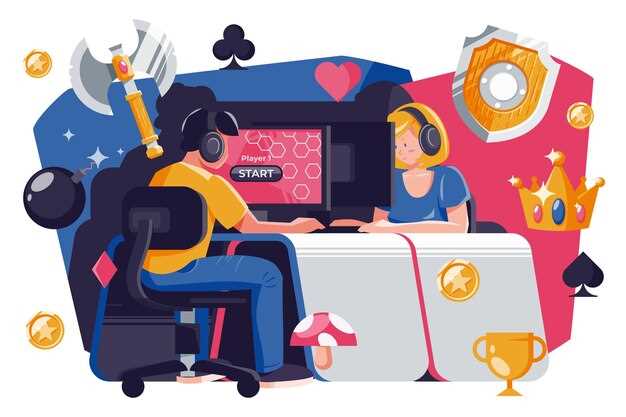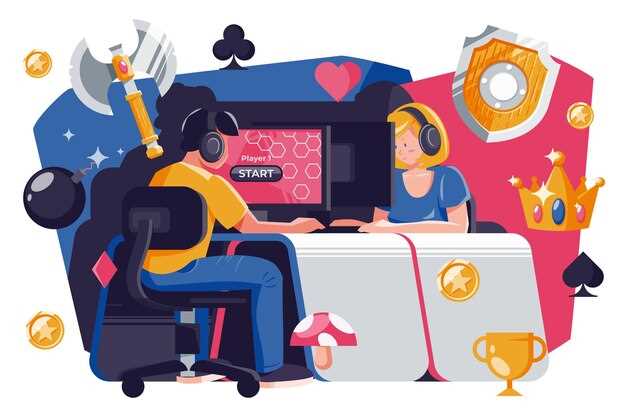Explore the profound connection between arcade games and cinematic storytelling. Arcade games have not only entertained millions but also inspired filmmakers to craft narratives that resonate with audiences globally. Understanding this influence reveals how gaming culture shapes character development, plot lines, and even special effects in contemporary cinema.
Consider iconic films like “Tron” and “Wreck-It Ralph,” which seamlessly integrate arcade aesthetics and concepts into their narratives. These movies showcase characters and worlds inspired by gaming mechanics, creating a unique viewing experience that appeals to both gamers and non-gamers alike.
Moreover, arcade games have sparked trends in the film industry, evident in the resurgence of retro themes and nostalgia-driven plots. As filmmakers tap into the rich history of arcade gaming, they draw from familiar experiences that strike a chord with audiences, celebrating the era of classic gaming while introducing it to new generations. The impact is clear: arcade games continue to leave an indelible mark on popular culture, affecting not just movies, but the broader entertainment landscape.
The Impact of Arcade Games on Popular Culture

Arcade games have significantly influenced popular culture, particularly in the film industry. Iconic titles like “Pac-Man” and “Street Fighter” have transitioned from pixelated screens to blockbuster films, showcasing their broad appeal. The 1982 film “Tron” marked one of the earliest examples of video game integration into cinema, bringing the digital realm to mainstream audiences. This fusion of gaming and film has led to a surge in adaptations, where captivating narratives from games hit the big screen.
Character Recognition and Merchandise
Characters from arcade games have become cultural icons. Figures like Mario and Sonic have crossed over into various forms of media, including toys, clothing, and animated series. This brand presence reinforces the connection between games and their audiences, driving merchandise sales and fostering a sense of community among fans. Expanding the universe of these characters encourages participation in multiple platforms, creating a cohesive cultural phenomenon.
Influence on Filmmaking Techniques
The aesthetics and storytelling techniques from arcade games influence filmmakers. Fast-paced action sequences, vibrant colors, and dynamic camera movements draw inspiration from arcade gameplay. Films such as “Ready Player One” highlight this trend, effectively blending gaming culture with cinematic storytelling. The incorporation of game-like elements into films engages a younger audience, bridging the gap between digital and traditional media.
Influence of Arcade Games in Film Narratives

Arcade games significantly shape film narratives, providing creators with a rich source of inspiration and a familiar touchstone for audiences.
- Character Development: Films often draw on arcade game archetypes. Characters like the hero, the villain, and the sidekick emerge from gaming traditions, allowing viewers to quickly identify traits and motivations. For example, the protagonist in “Ready Player One” channels classic gaming attributes that resonate with fans.
- Story Arcs: Many films incorporate game-like story structures. The “level-up” progression seen in arcade games influences the way plots unfold. Movies like “Wreck-It Ralph” mirror this progression, where characters face challenges that echo video game mechanics, enhancing audience engagement.
- Visual Aesthetics: The pixelated graphics and vibrant colors of arcade games often impact the visual style of films. “Pixels” plays with retro visuals, creating a nostalgic experience that appeals to both gamers and non-gamers alike.
- Thematic Elements: Common themes found in arcade games, such as competition and triumph over adversity, frequently appear in films. These themes resonate strongly, particularly in action and adventure genres, aligning viewer expectations with cinematic storytelling.
- Interactive Experiences: The rise of interactive cinema, inspired by video gaming, showcases a blend of both mediums. Movies like “Black Mirror: Bandersnatch” allow viewers to make choices, resembling game mechanics while enhancing narrative engagement.
Direct references to arcade games provide a familiar backdrop that enhances storytelling. Films like “Scott Pilgrim vs. The World” use gaming references to create humor and relatability, captivating audiences across generations.
Incorporating arcade culture into film not only entertains but bridges connections with diverse demographics, enriching cinematic narratives.
How Music Incorporates Arcade Game Sounds
Incorporate iconic sounds from arcade games to create a nostalgic atmosphere in your music. Utilize chiptune elements, characterized by 8-bit sounds reminiscent of classic titles, to evoke memories of gaming. Many contemporary artists integrate these sounds into their tracks, providing a retro yet fresh feel.
Layering arcade sound effects like coin drops, level-ups, and character moves can enhance the dynamic range of a song. For instance, utilizing a synthesized blip or beep can add an engaging backdrop while ensuring the piece remains modern. Daft Punk is a great example, infusing their works with game-inspired noises that appeal to both music and gaming fans.
Experiment with tempo and rhythm by mimicking the level progression of arcade games. A track could accelerate during a climactic moment, mirroring the intensity of a boss fight, then shift suddenly to a softer section, reflecting the downtime between levels. This keeps listeners engaged and draws them into a familiar game-like experience.
Sampling classic arcade titles also proves effective. Many artists pull snippets from well-known games. This practice not only builds connections with listeners but also pays homage to the original creators. Artists can use software like Ableton Live to manipulate these samples creatively, breathing new life into them.
Collaboration with video game musicians further enriches a project. Working with people who understand the intricacies of game sound design can yield innovative results. They can provide insights into creating authentic sounds and ensure the final mix resonates with listeners familiar with the gaming universe.
Attend live performances featuring chiptune artists to see how they engage audiences using these sounds dynamically. Their shows often feature visually stunning graphics that complement the music, creating an immersive environment. This combination can inspire new ways to incorporate visuals in your music videos or promotional materials.
Finally, consider the role of narrative. Many arcade games have storylines that engage players. Create music that tells a story, aligning with the gameplay’s episodic format. This can deepen the connection between listeners and the music while testing creative boundaries.
Pac-Man: A Cultural Icon and Its Legacy
Recognize Pac-Man as more than just a game; it’s a cultural phenomenon that shaped entertainment. Launched in 1980, it became a symbol of the arcade era. The simple yet addictive gameplay attracted diverse audiences, transcending age and gender. Its yellow character, with a distinct round shape, became recognizable worldwide, sparking various merchandise, from toys to clothing.
Identify the influence of Pac-Man on pop culture. The game’s catchy music and sound effects became iconic, leading to numerous covers and parodies. Pac-Man inspired animated series, comics, and even a feature film, showcasing its broad appeal. The famous “Pac-Man fever” of the early 80s highlighted its popularity, as hits like the song “Pac-Man Fever” topped charts, solidifying its place in entertainment history.
Explore how Pac-Man impacted video game design. It introduced concepts like power-ups and maze navigation, laying the groundwork for future titles. The blend of strategy and skill that players required influenced countless developers. Games today carry elements derived from Pac-Man, ensuring its legacy endures in modern titles.
Consider the social aspects of Pac-Man. It provided a communal experience, with players often gathering around arcade machines. Competing for high scores created a sense of camaraderie and competition. This shared experience helped establish gaming as a social activity, paving the way for multiplayer games and online gaming communities.
Reflect on the lasting legacy of Pac-Man in contemporary media. It remains a reference point in various forms of entertainment, appearing in TV shows, films, and even art exhibits. The character’s enduring popularity reinforces the impact of simple yet engaging gameplay on cultural identity, proving that Pac-Man is not just a relic of the past but a continuing influence in pop culture.
The Role of Arcade Games in Shaping Nostalgia
Arcade games evoke strong feelings of nostalgia by transporting players back to a simpler time. Classic titles like Pac-Man and Space Invaders fill players with memories of crowded game rooms and the joy of high scores. The sounds of pixelated beeps and boops are not just audio cues; they are time capsules that spark fond recollections of youth.
Cultural References in Modern Media
Many films and television shows leverage arcade games to anchor stories in the past. Movies such as “Ready Player One” and “Wreck-It Ralph” prominently feature these games, inviting audiences to reminisce about their own experiences in arcades. This effective use of nostalgia not only appeals to older generations but also introduces younger viewers to the charm of retro gaming.
The Emotional Connection
The emotional bond people form with arcade games often stems from shared experiences. Friends gathered around a machine, competing for the top score, forged connections that linger long after the game ends. This communal aspect of arcade gaming deepens its nostalgic impact, creating an atmosphere of camaraderie. Revisiting such games allows individuals to relive those moments, amplifying their emotional significance.
Space Invaders and Its Symbolism in Modern Media
The game “Space Invaders” symbolizes various themes that resonate strongly in contemporary media. Its representation of alien invasion embodies the classic battle between good and evil, reflecting societal anxieties about the unknown. Here are some ways this iconic game influences and appears in modern media:
1. Reflection of Societal Fears
The relentless onslaught of alien invaders mirrors contemporary concerns about external threats. Various media forms reinterpret these anxieties, showcasing how humanity responds to overwhelming challenges. This narrative framework engages audiences, allowing them to explore personal and collective fears.
- Films like “Arrival” depict alien encounters not merely as threats but as opportunities for dialogue and understanding.
- Television series such as “The X-Files” utilize alien themes to explore paranoia and distrust in government and institutions.
2. Cultural Iconography and Adaptations
Space Invaders’ distinctive graphics, sound effects, and gameplay have made it a cultural icon. Modern adaptations revive its essence while integrating new themes:
- Video games, such as “Galaga” and “Geometry Wars,” draw inspiration from its mechanics, creating nostalgic yet innovative experiences.
- Merchandise and collectibles featuring Space Invaders imagery highlight its status as a recognizable symbol in popular culture.
Studios often reference or parody Space Invaders, showcasing its enduring relevance. This recognition fosters connections with audiences familiar with the original game, reinforcing its position within contemporary narratives.
In summary, “Space Invaders” serves as a powerful symbol in modern media, reflecting societal fears and inspiring countless adaptations and references. Its impact continues to shape how stories of conflict and resilience are told today.
Cross-Promotion: Arcade Games in Advertising Campaigns
Incorporate arcade games into advertising strategies to boost brand visibility and engage audiences. Brands can create themed arcade cabinets or utilize popular game elements within their campaigns. This approach not only attracts gamers but also taps into nostalgia, creating a connection with a wider demographic.
Interactive Experiences
Design interactive experiences where consumers play arcade games to earn rewards or discounts. For example, a fast-food chain might feature an arcade game where players win coupons for free meals. This not only attracts foot traffic but also provides entertainment, making the brand memorable.
Collaborative Promotions
Partner with game developers to launch exclusive in-game content tied to a product. For instance, a movie release can include characters or themes from the film in a popular arcade game. This approach builds anticipation and encourages players to engage with both the game and the film, creating a holistic promotion that resonates with fans.
The Rise of eSports: From Arcade to Championship
The transition from arcade games to eSports showcases the growth of competitive gaming. Arcade cabinets ignited player passion, sparking local competitions, fostering community connections, and building a foundation for larger events. These local tournaments laid the groundwork for eSports, where players now compete globally for substantial prizes.
Competitive Formats and Game Diversity
Modern eSports features diverse titles like League of Legends, Dota 2, and Counter-Strike: Global Offensive. Each game offers unique mechanics and attracts specialized audiences. Major tournaments, such as The International, showcase skilled players on global stages, with viewership numbers rivaling traditional sports events. Keep an eye on emerging games in the eSports space, as they often create new opportunities for players and fans alike.
Investment and Sponsorship Growth
Investment in eSports has surged, with companies recognizing its potential. Sponsorship deals from brands like Intel and Red Bull elevate tournaments, enhancing production quality and attracting larger audiences. Leveraging social media platforms allows teams and sponsors to engage with fans directly. As eSports continues to grow, so does the opportunity for aspiring athletes to showcase their skills and gain visibility.
Arcade Game References in Contemporary TV Shows
Contemporary TV shows often incorporate arcade game references, creating a nostalgic connection for viewers. This choice reflects the cultural significance of these games, symbolizing fun and camaraderie. Programs like “Stranger Things” and “The Big Bang Theory” consistently highlight arcade games, showcasing their impact on character dynamics and plot development.
Stranger Things
In “Stranger Things,” the characters frequently engage in gameplay at the local arcade, referencing classics like “Dragon’s Lair” and “Dig Dug.” These moments not only evoke nostalgia but also serve as a backdrop for significant character interactions. The arcade becomes a hub of friendship and conflict, illustrating how these games influence their relationships.
The Big Bang Theory
“The Big Bang Theory” features numerous arcade game references, such as “Pac-Man” and “Street Fighter.” These games are often woven into storylines, enhancing humor and relatability. The characters use gaming as a means to bond, emphasizing the social aspect of arcade culture.
| Show | Arcade Game References | Impact on Characters |
|---|---|---|
| Stranger Things | Dragon’s Lair, Dig Dug | Friendship, Conflict Resolution |
| The Big Bang Theory | Pac-Man, Street Fighter | Bonding, Humor |
These references enrich narrative depth, making arcade games a compelling element within modern television storytelling. Engaging with these nostalgic icons allows audiences to connect personally with the characters and their experiences.
Video:
#G4C12: The Next Gen Arcades: Games with Social Impact in Cultural Spaces
#G4C12: The Next Gen Arcades: Games with Social Impact in Cultural Spaces by Games for Change 102 views 12 years ago 14 minutes, 30 seconds
Q&A:
How have arcade games influenced movies in popular culture?
Arcade games have had a significant influence on movies, particularly in how they shape narratives, visual aesthetics, and character developments. Directors and writers often draw inspiration from the interactive experience of gameplay, leading to films that reflect the excitement and engagement of arcade culture. For instance, films like “Tron” and “Wreck-It Ralph” showcase how arcade games can be transformed into cinematic experiences, highlighting the vibrant environments and conflict-driven plots typical of gaming.
What are some examples of movies directly inspired by arcade games?
Several movies are directly inspired by arcade games. “Tron,” released in 1982, is one of the earliest examples, depicting a computer world where a programmer gets trapped in a digital landscape. Another notable film is “Wreck-It Ralph,” which brings classic arcade characters to life and explores themes of identity and redemption. More recent examples include “Pixels,” which features characters from iconic arcade games like “Pac-Man” and “Donkey Kong,” showcasing how these games can influence modern storytelling in cinema.
How have arcade games influenced character development in films?
Arcade games often present characters with specific attributes or skills that translate well to film. Characters in movies inspired by arcade games frequently embody traits of those they represent, such as bravery, quick thinking, and resilience. For example, Ralph from “Wreck-It Ralph” starts as a villain but seeks acceptance, reflecting the journey many players experience in video games as they strive for progress and self-improvement. This character arc resonates with audiences familiar with the gaming concepts of leveling up and transformation.
What role do soundtracks from arcade games play in films?
Soundtracks from arcade games play a vital role in establishing mood and nostalgia in films. Cinematic adaptations often incorporate iconic 8-bit music or remixes of classic game soundtracks to evoke a sense of familiarity and connection for viewers who grew up with arcade gaming. For instance, the use of retro music in movies like “Scott Pilgrim vs. The World” enhances the film’s playful tone and references gaming culture, creating an immersive experience that appeals to both gamers and non-gamers alike.
Can you explain the significance of visual style taken from arcade games in films?
The visual style of arcade games has greatly influenced the aesthetics of many films. The vivid colors, pixelated graphics, and unique character designs found in arcade games have been translated into the cinematic realm to create dynamic and engaging visuals. Movies like “The Lego Movie” showcase this integration, using blocky animations that echo the feel of classic games. By adopting these styles, filmmakers can tap into the nostalgia of audiences, making the visuals appealing while honoring the history of arcade gaming.
How have arcade games influenced the themes and characters in movies?
Arcade games have had a significant influence on movies, particularly in shaping themes and character archetypes. Many films have incorporated elements from popular arcade games, leading to the creation of characters that often reflect the traits of arcade game protagonists. For instance, the idea of a hero overcoming a series of challenges to achieve a goal can be traced back to classic arcade gameplay, where players must navigate obstacles and defeat enemies. Additionally, movies like “Wreck-It Ralph” directly reference the arcade game culture, showcasing characters that inhabit a game world. This blending of narrative styles allows filmmakers to explore concepts of competition, adventure, and heroism in ways that resonate with audiences familiar with game mechanics.
What role have arcade games played in shaping the visual style of modern films?
Arcade games have played a notable role in shaping the visual style of modern films, particularly in the way filmmakers employ bright colors, distinctive graphics, and fast-paced editing. The aesthetic of 8-bit and 16-bit graphics has influenced movies that seek to capture the nostalgia of the arcade experience. Films such as “Scott Pilgrim vs. The World” utilize visual effects reminiscent of video games, including pixelation and HUD overlays, creating an immersive environment that pays homage to arcade gaming. This visual homage not only targets gamers but also appeals to a broader audience by providing a unique visual experience. The incorporation of game-inspired aesthetics in cinematography helps to create an energetic atmosphere that enhances storytelling and draws viewers into the cinematic world.



